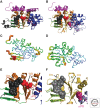Cystic fibrosis transmembrane conductance regulator (ABCC7) structure
- PMID: 23378596
- PMCID: PMC3552343
- DOI: 10.1101/cshperspect.a009514
Cystic fibrosis transmembrane conductance regulator (ABCC7) structure
Abstract
Structural studies of the cystic fibrosis transmembrane conductance regulator (CFTR) are reviewed. Like many membrane proteins, full-length CFTR has proven to be difficult to express and purify, hence much of the structural data available is for the more tractable, independently expressed soluble domains. Therefore, this chapter covers structural data for individual CFTR domains in addition to the sparser data available for the full-length protein. To set the context for these studies, we will start by reviewing structural information on model proteins from the ATP-binding cassette (ABC) transporter superfamily, to which CFTR belongs.
Figures






References
-
- Aleksandrov AA, Aleksandrov L, Riordan JR 2002a. Nucleoside triphosphate pentose ring impact on CFTR gating and hydrolysis. FEBS Lett 518: 183–188 - PubMed
-
- Aleksandrov L, Aleksandrov AA, Chang XB, Riordan JR 2002b. The first nucleotide binding domain of cystic fibrosis transmembrane conductance regulator is a site of stable nucleotide interaction, whereas the second is a site of rapid turnover. J Biol Chem 277: 15419–15425 - PubMed
-
- Aleksandrov AA, Aleksandrov LA, Riordan JR 2007. CFTR (ABCC7) is a hydrolyzable-ligand-gated channel. Pflugers Arch 453: 693–702 - PubMed
-
- Aleksandrov L, Aleksandrov A, Riordan JR 2008. Mg2+-dependent ATP occlusion at the first nucleotide-binding domain (NBD1) of CFTR does not require the second (NBD2). Biochem J 416: 129–136 - PubMed
Publication types
MeSH terms
Substances
LinkOut - more resources
Full Text Sources
Other Literature Sources
Medical
